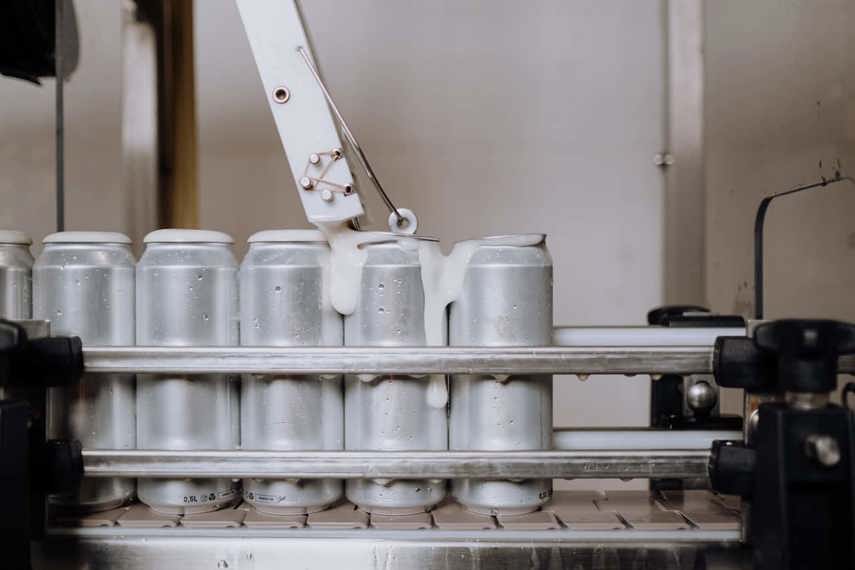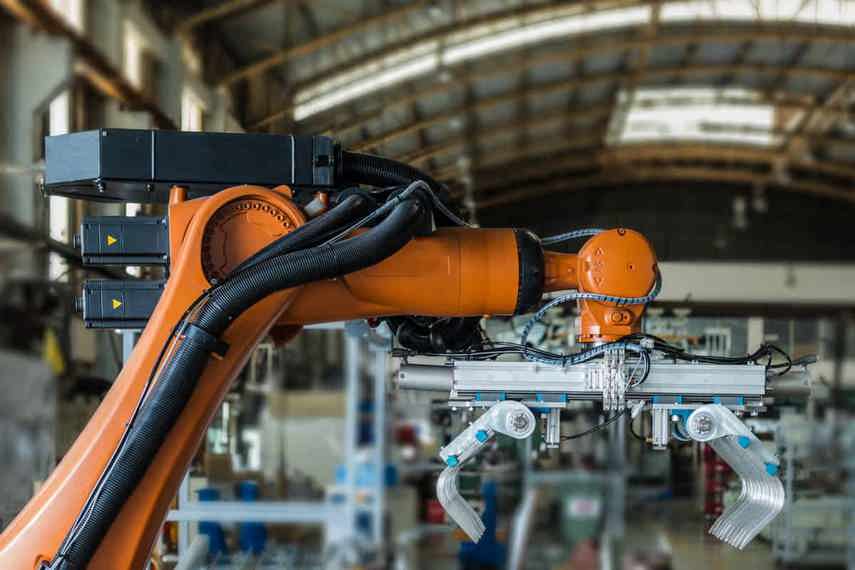
If manual processes are slowing your business and stunting your growth, it’s time to consider factory automation. In this guide we’ll outline how your business could profit from factory automation and how best to implement it.
What is factory automation?
Factory automation involves introducing technology to your manufacturing processes with a focus on improving efficiency, limiting human error, and automating dangerous or unpleasant jobs.
Factory automation should also remove non-production administrative tasks from your workflows and help your employees put more time and effort into tasks that more directly drive profit.
Factory automation can include:
- Robotics
- Software solutions
- Computer numerical control (CNC) machinery
Whatever the pain points on your factory floor, there’s likely a digital tool that can help.
 Factory automation can improve efficiency, limit human error, and manage dangerous or unpleasant jobs.
Factory automation can improve efficiency, limit human error, and manage dangerous or unpleasant jobs.
How does factory automation work?
Depending on the factory automation you have in place, the way it works will vary.
For example, JR Automation are a global robotics company that supply multiple different industries.
An aerospace customer required large-scale robotics to automate component processing and conveyors so JR Automation provided them with a cell controller that was able to complete part scheduling, line balancing, tool life monitoring, and work instructions.
JR Automation have also provided packaging and palletising solutions to businesses in the drainage industry, solar panel test systems to the renewable-energy industry, and vaccine testing systems to the medical.
Factory automation benefits
You should expect multiple benefits to increasing automation in your factory, from long-term cost savings to higher productivity.
Here are the four main ways you'll improve your business:
- Optimised productivity: A study by McKinsey predicts that automation will raise global productivity growth by 0.8% to 1.4% annually.
- Scalability: With less time spent on administrative tasks, your high-skilled employees can focus their efforts on scaling your business and growing revenue.
- Improved customer satisfaction: A study by software automation firm Zapier found that 66% of SMB employees say using automation at work lets them focus on more creative tasks and projects, and 1 in 5 say that automation increases the accuracy and efficiency of their work. More time spent on creating quality products reduces complaints and increases positive feedback from customers.
- Increased ROI: Productivity, business growth, and high customer satisfaction levels is an unrivalled formula for healthy profit margins. Factory automation is an investment that will generate greater return on investment.
According to a McKinsey study titled “The Imperatives For Automation Success” 72 percent of survey respondents from large companies with successful automation in place credit making it a strategic priority as one of the most important factors in their companies’ achievements.
 Staff at productive firms cite strategic automation as a reason for their success.
Staff at productive firms cite strategic automation as a reason for their success.
4 types of factory automation
To know what type of automation is right for your business, you need to understand the basics.
The type of factory automation you opt for depends on the product you manufacture, the level of demand for your product, and your investment budget.
Fixed automation
This type of factory automation is used by manufacturers that produce a high volume of products as it involves automating a repetitive task, usually along a production line.
Advantages:
- High production rates.
- Can safely perform dangerous and tedious tasks.
Disadvantages:
- Initial setup can be expensive.
- Limits flexibility in altering your products.
Programmable automation
This type of factory automation is most often employed by product businesses that produce quantities in batch. Programmable machinery is configurable and can be coded to manufacture varying product designs.
Advantages:
- Allows you to offer varying product designs to customers.
- Able to produce batch quantities.
Disadvantages:
- Reprogramming requirements make production rates lower.
Flexible automation
This type of factory automation requires the highest level of human intervention.
The machines involved in flexible automation are controlled by a human-operated computer so you can produce different product designs without reprogramming your machine.
Advantages:
- Adaptable to production demands.
- Performs tasks with extreme precision and speed.
Disadvantages:
- High setup and investment costs.
- Requires employees with some technical skills to operate.
Data automation
Factory automation isn’t all robots and heavy-duty machinery. To sustain a successful production line, you need to have well-founded software systems in place.
Cloud-based manufacturing software is designed to help you organise your manufacturing planning and processes and make data-driven decisions that improve performance.
Gartner’s 2023 Global Software Buying Trends report revealed that 27% of business leaders purchased new software to expand product offerings, and 37% to increase productivity.
From managing your inventory to streamlining your sales process, factory automation that involves a cloud-based solution will lay a foundation for success.
 Software features such as serial number tracking help automate production processes for manufacturers.
Software features such as serial number tracking help automate production processes for manufacturers.
Examples of automation in a factory
The factory automation you choose can benefit or hinder production management, depending on factors like how dangerous your processes are and how many employees you already have working on your assembly line.
Automation via integrated software
Before deploying an integrated solution, Good Culture Kombucha – a global distributor of Kombucha ingredients – had systems in place that didn’t communicate. This made their operations disjointed.
“We felt like we were double-handling everything because they weren’t integrated,” said Jessica Powell, Business Manager at Good Culture Kombucha.
They wanted to find an alternative to recording their stock and customer data on a spreadsheet, and something that automated elements of their sales process like opportunity tracking.
Good Culture Kombucha chose to integrate Unleashed with Prospect CRM and have since seen many improvements in their sales and inventory management processes.
Over the last 12 months, their sales have doubled. They’re now able to see what stock is available and know when to follow up on customers to reduce churn rates thanks to automated insights and notifications.
“Investing in Prospect CRM and Unleashed is the backbone of my business and probably one of the best decisions I’ve made,” says Denis Kelleher, Founder/CEO, the company’s founder and CEO.
Quality control automation
If customers regularly complain about the quality of your products, and you see problem tickets building quickly, you likely need a quality assessment process in place.
However manual quality control processes can be time consuming and unpopular with staff. According to a study by Zapier, 94% of SMB employees say they perform repetitive, time-consuming tasks in their role. So automation of quality checks is an attractive option.
Peloton, a global distributor of fitness equipment, was forced to recall more than 125,000 treadmills in the US alone following serious safety incidents. However, Fujitsu explains that the company is now deploying an AI-enabled defect recognition system with the potential to drive a 50% increase in throughput and are now driving down manufacturing costs in a lasting way.
Robotic assistance in quality control typically involves a machine checking that your final products adhere to a standardised specification. For example, quality control machines can assess the dimensions of your product, check for major and minor defects, and can ensure packaging is secure.
Quality control automation also helps businesses maintain a balance between fast production rates and safe and enjoyable conditions for staff.
 Heavy lifting robots have become increasingly affordable.
Heavy lifting robots have become increasingly affordable.
Heavy lifting robots
Handling heavy materials around a factory can be dangerous, and workplace injuries are costly. According to the UK Health and Safety Executive, the total costs in Britain alone of workplace self-reported injuries and ill health in 2019/20 was £18.8 billion.
Increasingly automated heavy lifting tools are able to handle injury prone tasks in the factory and warehouse – whether that’s automatically picking orders at height in the warehouse, or shifting large items off an assembly line.
Examples of factory automation software
There is now a wide range of software products for automating manufacturing processes. Below are some of the most popular.
Manufacturing Inventory Management
“When we’re travelling, wherever we are, we can see how the business is tracking. We can see the number of sales that day and we can see our margins.” – Matt Morrison, Co-founder, Karma Cola.
Automated inventory management software creates a virtual duplicate your inventory and tracks the status of your stock throughout the production and shipping journey.
Having full traceability of your inventory with tools like batch and serial number tracking means that you can view the movement of your products at any time, from any place. This degree of stock awareness reduces business costs by matching your stock levels to demand.
As your business scales, manufacturing inventory management software will help you keep on top of orders, keep stock levels within healthy levels, and maintain customer satisfaction. And fast order fulfilment powered by your inventory management software will optimise your customers’ buying journey so they’re less likely to move on to a competitor.
B2B Customer Relationship Management (CRM)
“We know when to follow up with people, how regularly, who is slipping down and not ordering as much, and who are really regular customers.” – Jessica Powell, Business Manager, Good Culture Kombucha.
CRM software automates the processes within your quote-to-order workflow and reporting system.
By surfacing real-time customer and sales insights, CRM software takes the manual admin processes out of your team’s working day. This allows employees to spend their time more productively.I’m
While a CRM’s primary focus is on documenting your customer interactions and automating your sales process, some CRM with inventory systems like Prospect CRM give your Sales and Marketing teams stock awareness so they can make data-driven decisions.
A CRM system that integrates with your existing platforms allows you to convert quotes into active orders with the click of a button, sending order data to your manufacturing inventory system for your Operations team to work with.
Manufacturing accounting software
Accounting software gives you a full picture of your business’s finances and automates invoices and financial reporting.
When a customer places an order, this transaction is automatically sent to and stored in a system like Xero where you can keep track of your cashflow.
Not only can you track your customers’ transactions with accounting software, you can also pay bills, offer multi-currency accounting, and calculate taxes automatically.
Manufacturing accounting software essentially introduces automation to your business’s bookkeeping functions so you can scale while maintaining healthy margins.
Software integration
While inventory management, CRM, and accounting software will give you the insights you need, they work better together.
Having multiple automated systems that don’t communicate with one another makes manufacturing operations more complicated. Switching back and forth between applications can become time consuming, so it’s essential that your platforms are integrated.
Before investing in software, make sure to check their App Marketplace and some trusted software review sites to ensure that it integrates well with your existing platforms.
